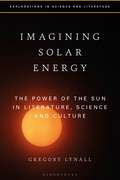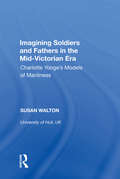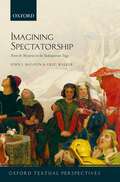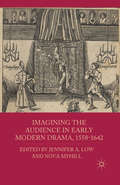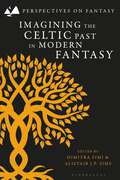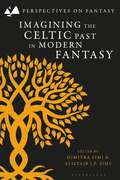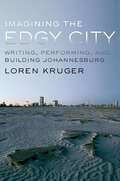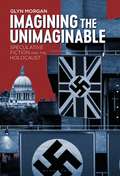- Table View
- List View
Imagining Solar Energy: The Power of the Sun in Literature, Science and Culture (Explorations in Science and Literature)
by Gregory LynallHow has humanity sought to harness the power of the Sun, and what roles have literature, art and other cultural forms played in imagining, mythologizing and reflecting the possibilities of solar energy? What stories have been told about solar technologies, and how have these narratives shaped developments in science and culture? What can solar power's history tell us about its future, within a world adapting to climate crisis? Identifying the history of capturing solar radiance as a focal point between science and the imagination, Imagining Solar Energy argues that the literary, artistic and mythical resonances of solar power – from the Renaissance to the present day – have not only been inspired by, but have also cultivated and sustained its scientific and technological development. Ranging from Archimedes to Isaac Asimov, John Dee to Humphry Davy, Aphra Behn to J. G. Ballard, the book argues that solar energy translates into many different kinds of power (physical, political, intellectual and cultural), and establishes for the first time the importance of solar energy to many literary and scientific endeavours.
Imagining Soldiers and Fathers in the Mid-Victorian Era: Charlotte Yonge's Models of Manliness
by Susan WaltonBeginning with the premise that women's perceptions of manliness are crucial to its construction, The author focuses on the life and writings of Charlotte Yonge as a prism for understanding the formulation of masculinities in the Victorian period. Yonge was a prolific writer whose bestselling fiction and extensive journalism enjoyed a wide readership. The author situates Yonge's work in the context of her family connections with the army, showing that an interlocking of worldly and spiritual warfare was fundamental to Yonge's outlook. For Yonge, all good Christians are soldiers, and Walton argues persuasively that the medievalised discourse of sanctified violence executed by upright moral men that is often connected with late nineteenth-century Imperialism began earlier in the century, and that Yonge's work was one major strand that gave it substance. Of significance, Yonge also endorsed missionary work, which she viewed as an extension of a father's duties in the neighborhood and which was closely allied to a vigorous promotion of refashioned Tory paternalism. The author's study is rich in historical context, including Yonge's connections with the Tractarians, the effects of industrialization, and Britain's Imperial enterprises. Informed by extensive archival scholarship, Walton offers important insights into the contradictory messages about manhood current in the mid-nineteenth century through the works of a major but undervalued Victorian author.
Imagining Soldiers and Fathers in the Mid-Victorian Era: Charlotte Yonge's Models of Manliness
by Susan WaltonBeginning with the premise that women's perceptions of manliness are crucial to its construction, The author focuses on the life and writings of Charlotte Yonge as a prism for understanding the formulation of masculinities in the Victorian period. Yonge was a prolific writer whose bestselling fiction and extensive journalism enjoyed a wide readership. The author situates Yonge's work in the context of her family connections with the army, showing that an interlocking of worldly and spiritual warfare was fundamental to Yonge's outlook. For Yonge, all good Christians are soldiers, and Walton argues persuasively that the medievalised discourse of sanctified violence executed by upright moral men that is often connected with late nineteenth-century Imperialism began earlier in the century, and that Yonge's work was one major strand that gave it substance. Of significance, Yonge also endorsed missionary work, which she viewed as an extension of a father's duties in the neighborhood and which was closely allied to a vigorous promotion of refashioned Tory paternalism. The author's study is rich in historical context, including Yonge's connections with the Tractarians, the effects of industrialization, and Britain's Imperial enterprises. Informed by extensive archival scholarship, Walton offers important insights into the contradictory messages about manhood current in the mid-nineteenth century through the works of a major but undervalued Victorian author.
Imagining Spectatorship: From the Mysteries to the Shakespearean Stage (Oxford Textual Perspectives)
by John J. McGavin Greg WalkerOxford Textual Perspectives is a new series of informative and provocative studies focused upon literary texts (conceived of in the broadest sense of that term) and the technologies, cultures and communities that produce, inform, and receive them. It provides fresh interpretations of fundamental works and of the vital and challenging issues emerging in English literary studies. By engaging with the materiality of the literary text, its production, and reception history, and frequently testing and exploring the boundaries of the notion of text itself, the volumes in the series question familiar frameworks and provide innovative interpretations of both canonical and less well-known works. Imagining Spectatorship offers a new discussion of how spectators witnessed early drama in the various spaces and places in which those works were performed. It combines broad historical and theoretical reflection with closely analysed case studies to produce a comprehensive account of the ways in which individuals encountered early drama, how they were cued to respond to it, and how we might think about those issues today. It addresses the practical matters that conditioned spectatorship, principally those concerned with the location and configuration of the spaces in which a performance occurred, but also suggests how these factors intersected with social status, gender, religious commitment and affiliation, degrees of real or felt personal agency, and the operation of the cognitive processes themselves. It considers both real witnesses and those 'imagined' spectators which are seemingly figured by both dramatic and quasi-dramatic works, and whose assumed attitudes play-makers sought to second-guess. It also looks at the spectatorial experience itself as a subject of representation in a number of early texts. Finally, it examines the complex contract entered into by audiences and players for the duration of a performance, looking at how texts cued spectators to respond to specific dramaturgical tropes and gambits and how audience response was itself a cause of potential anxiety for writers. The book resists the conventional divide between 'medieval' and 'early-modern' drama, using its focus on the spectators' experience to point connections and continuities across a diverse range of genres, such as processions and tourneys as well as scripted plays, pageants, and interludes; a variety of different venues, such as city streets, great halls, and playhouses, and a period of about 150 years to the Shakespearean stage of the 1590s and 1600s. It seeks to offer routes by which inferences about early spectatorship can be made despite the relative absence of personal testimony from the period.
Imagining Surveillance: Utopian and Dystopian Literature and Film
by Peter MarksCritically assesses how literary and cinematic eutopias and dystopias have imagined and evaluated surveillance. Imagining Surveillance presents the first full-length study of the depiction and assessment of surveillance in literature and film. Focusing on the utopian genre (which includes positive and negative worlds), this book offers an in-depth account of the ways in which the most creative writers, filmmakers and thinkers have envisioned alternative worlds in which surveillance in various forms plays a key concern. Ranging from Thomas More’s genre-defining Utopia to Spike Jones’ provocative film Her, Imagining Surveillance explores the long history of surveillance in creative texts well before and after George Orwell’s iconic Nineteen Eighty-Four. It fits that key novel into a five hundred year narrative that includes some of the most provocative and inventive accounts of surveillance as it is and as it might be in the future. The book explains the sustained use of these works by surveillance scholars, but goes much further and deeper in explicating their brilliant and challenging diversity. With chapters on surveillance studies, surveillance in utopias before Orwell, Nineteen Eighty-Four itself, and utopian texts post-Orwell that deal with visibility, spaces, identity, technology and the shape of things to come, Imagining Surveillance sits firmly in the emerging cultural studies of surveillance. Key Features: The first sustained account of the representation of surveillance in eutopian and dystopian literature and film Charts surveillance’s historical development and creative responses to that development Provides a detailed critical account of the ways that surveillance studies has utilised utopias to formulate its ideas Offers new readings of literary texts and films from More’s Utopia through George Orwell’s Nineteen Eighty-Four to Margaret Atwood’s Oryx and Crake and films from Fritz Lang’s Metropolis to Neil Blomkamp’s Elysium and beyond
Imagining Surveillance: Utopian and Dystopian Literature and Film
by Peter MarksCritically assesses how literary and cinematic eutopias and dystopias have imagined and evaluated surveillance. Imagining Surveillance presents the first full-length study of the depiction and assessment of surveillance in literature and film. Focusing on the utopian genre (which includes positive and negative worlds), this book offers an in-depth account of the ways in which the most creative writers, filmmakers and thinkers have envisioned alternative worlds in which surveillance in various forms plays a key concern. Ranging from Thomas More’s genre-defining Utopia to Spike Jones’ provocative film Her, Imagining Surveillance explores the long history of surveillance in creative texts well before and after George Orwell’s iconic Nineteen Eighty-Four. It fits that key novel into a five hundred year narrative that includes some of the most provocative and inventive accounts of surveillance as it is and as it might be in the future. The book explains the sustained use of these works by surveillance scholars, but goes much further and deeper in explicating their brilliant and challenging diversity. With chapters on surveillance studies, surveillance in utopias before Orwell, Nineteen Eighty-Four itself, and utopian texts post-Orwell that deal with visibility, spaces, identity, technology and the shape of things to come, Imagining Surveillance sits firmly in the emerging cultural studies of surveillance. Key Features: The first sustained account of the representation of surveillance in eutopian and dystopian literature and film Charts surveillance’s historical development and creative responses to that development Provides a detailed critical account of the ways that surveillance studies has utilised utopias to formulate its ideas Offers new readings of literary texts and films from More’s Utopia through George Orwell’s Nineteen Eighty-Four to Margaret Atwood’s Oryx and Crake and films from Fritz Lang’s Metropolis to Neil Blomkamp’s Elysium and beyond
Imagining the Audience in Early Modern Drama, 1558-1642
by Jennifer A. Low & Nova MyhillThis essay collection builds on the latest research on the topic of theatre audiences in early modern England. In broad terms, the project answers the question, 'How do we define the relationships between performance and audience?'.
Imagining the Black Female Body: Reconciling Image in Print and Visual Culture
by Carol E. HendersonThis volume explores issues of black female identity through the various "imaginings" of the black female body in print and visual culture. Contributions emphasize the ways in which the black female body is framed and how black women (and their allies) have sought to write themselves back into social discourses on their terms.
Imagining the Cape Colony: History, Literature, and the South African Nation (Edinburgh University Press)
by David JohnsonBy returning to a pivotal moment in South African history - the Cape Colony in the period 1770-1830 - this book addresses current debates about nationalism, colonialism and neo-colonialism, and postcolonial/post-apartheid culture.
Imagining the Celtic Past in Modern Fantasy (Perspectives on Fantasy)
by Dimitra Fimi and Alistair J.P. SimsFocusing on representations of Celtic motifs and traditions in post-1980s adult fantasy literature, this book illuminates how the historical, the mythological and the folkloric have served as inspiration for the fantastic in modern and popular culture of the western world. Bringing together both highly-acclaimed works with those that have received less critical attention, including French and Gaelic fantasy literature, Imagining the Celtic Past in Modern Fantasy explores such texts as Susanna Clarke's Jonathan Strange & Mr Norrell, Alan Garner's Weirdstone trilogy, the Irish fantasies of Jodi McIsaac, David Gemmell's Rigante novels, Patricia Kennealy-Morrison Keltiad books, as well as An Sgoil Dhubh by Iain F. MacLeòid and the Vertigen and Frontier series by Léa Silhol. Lively and covering new ground, the collection examines topics such as fairy magic, Celtic-inspired worldbuilding, heroic patterns, classical ethnography and genre tropes alongside analyses of the Celtic Tarot in speculative fiction and Celtic appropriation in fan culture. Introducing a nuanced understanding of the Celtic past, as it has been informed by recent debates in Celtic studies, this wide-ranging and provocative book shows how modern fantasy is indebted to medieval Celtic-language texts, folkloric traditions, as well as classical sources.
Imagining the Celtic Past in Modern Fantasy (Perspectives on Fantasy)
Focusing on representations of Celtic motifs and traditions in post-1980s adult fantasy literature, this book illuminates how the historical, the mythological and the folkloric have served as inspiration for the fantastic in modern and popular culture of the western world. Bringing together both highly-acclaimed works with those that have received less critical attention, including French and Gaelic fantasy literature, Imagining the Celtic Past in Modern Fantasy explores such texts as Susanna Clarke's Jonathan Strange & Mr Norrell, Alan Garner's Weirdstone trilogy, the Irish fantasies of Jodi McIsaac, David Gemmell's Rigante novels, Patricia Kennealy-Morrison Keltiad books, as well as An Sgoil Dhubh by Iain F. MacLeòid and the Vertigen and Frontier series by Léa Silhol. Lively and covering new ground, the collection examines topics such as fairy magic, Celtic-inspired worldbuilding, heroic patterns, classical ethnography and genre tropes alongside analyses of the Celtic Tarot in speculative fiction and Celtic appropriation in fan culture. Introducing a nuanced understanding of the Celtic past, as it has been informed by recent debates in Celtic studies, this wide-ranging and provocative book shows how modern fantasy is indebted to medieval Celtic-language texts, folkloric traditions, as well as classical sources.
Imagining the Dead in British Literature and Culture, 1790–1848
by David McAllisterThis book offers the first account of the dead as an imagined community in the early nineteenth-century. It examines why Romantic and Victorian writers (including Wordsworth, Dickens, De Quincey, Godwin, and D’Israeli) believed that influencing the imaginative conception of the dead was a way to either advance, or resist, social and political reform. This interdisciplinary study contributes to the burgeoning field of Death Studies by drawing on the work of both canonical and lesser-known writers, reformers, and educationalists to show how both literary representation of the dead, and the burial and display of their corpses in churchyards, dissecting-rooms, and garden cemeteries, responded to developments in literary aesthetics, psychology, ethics, and political philosophy. Imagining the Dead in British Literature and Culture, 1790-1848 shows that whether they were lauded as exemplars or loathed as tyrants, rendered absent by burial, or made uncannily present through exhumation and display, the dead were central to debates about the shape and structure of British society as it underwent some of the most radical transformations in its history.
Imagining the Edgy City: Writing, Performing, and Building Johannesburg
by Loren Kruger"All roads lead to Johannesburg," remarks the narrator of Alan Paton's novel Cry, The Beloved Country. Taking this quote as her impetus, Loren Kruger guides readers into the heart of South Africa's largest city. Exploring a wide range of fiction, film, architecture, performance, and urban practices from trading to parades, Imagining the Edgy City traverses Johannesburg's rich cultural terrain over the last century. The "edgy city" in Kruger's exploration refers not only to persistent boundaries between the haves and have-nots but also to the cosmopolitan diversity and innovation that has emerged from Johannesburg. The book begins with the building boom, performances and uneven but noteworthy inter-racial exchange that marked the city's fiftieth-anniversary celebration at the Empire Exhibition in 1936. This celebration rapidly gave way to the political repression and civil unrest that characterized South Africa from 1950 to 1990. Yet poetry, drama, fiction, and photography continued to thrive, bearing witness not only against apartheid but to alternatives beyond it. In the late twentieth century, the not quite post-apartheid condition fired the artistic imaginations of film makers as well as novelists. Urban neglect, rising crime, and the influx of migrants inspired noir cinema-like Michael Hammon's Wheels and Deals-and fiction about migration from Achmat Dangor to Phaswane Mpe, and in the twenty-first, urban renewal has produced public art that incorporates the desire lines of newcomers as well as natives. Alongside well-known artists such as Nadine Gordimer, William Kentridge, and David Goldblatt, the book introduces many artists, architects, writers, and other chroniclers who have hitherto received little attention abroad. Ultimately, Johannesburg emerges as a city whose negotiation of the tensions between incivility and innovation invites comparisons with modern conurbations across the world, not only African cities such as Dakar, or other cities of the "south" such as Bogotá, but also with major metropolises in North America and Europe from Chicago to Paris. A multi-faceted work that speaks to scholars in urban studies, literature, and history, Imagining the Edgy City is a rich example of interdisciplinary scholarship at its best.
Imagining the Forest: Narratives of Michigan and the Upper Midwest
by John R. KnottForests have always been more than just their trees. The forests in Michigan (and similar forests in other Great Lakes states such as Wisconsin and Minnesota) played a role in the American cultural imagination from the beginnings of European settlement in the early nineteenth century to the present. Our relationships with those forests have been shaped by the cultural attitudes of the times, and people have invested in them both moral and spiritual meanings. Author John Knott draws upon such works as Simon Schama's Landscape and Memory and Robert Pogue Harrison's Forests: The Shadow of Civilization in exploring ways in which our relationships with forests have been shaped, using Michigan---its history of settlement, popular literature, and forest management controversies---as an exemplary case. Knott looks at such well-known figures as William Bradford, James Fenimore Cooper, John Muir, John Burroughs, and Teddy Roosevelt; Ojibwa conceptions of the forest and natural world (including how Longfellow mythologized them); early explorer accounts; and contemporary literature set in the Upper Peninsula, including Jim Harrison's True North and Philip Caputo's Indian Country. Two competing metaphors evolved over time, Knott shows: the forest as howling wilderness, impeding the progress of civilization and in need of subjugation, and the forest as temple or cathedral, worthy of reverence and protection. Imagining the Forestshows the origin and development of both.
Imagining the Irish child: Discourses of childhood in Irish Anglican writing of the seventeenth and eighteenth centuries
by Jarlath KilleenThis book examines the ways in which ideas about children, childhood and Ireland changed together in Irish Protestant writing of the seventeenth and eighteenth centuries. It focuses on different varieties of the child found in the work of a range of Irish Protestant writers, theologians, philosophers, educationalists, politicians and parents from the early seventeenth century up to the outbreak of the 1798 Rebellion. The book is structured around a detailed examination of six ‘versions’ of the child: the evil child, the vulnerable/innocent child, the political child, the believing child, the enlightened child, and the freakish child. It traces these versions across a wide range of genres (fiction, sermons, political pamphlets, letters, educational treatises, histories, catechisms and children’s bibles), showing how concepts of childhood related to debates about Irish nationality, politics and history across these two centuries.
Imagining the Irish child: Discourses of childhood in Irish Anglican writing of the seventeenth and eighteenth centuries
by Jarlath KilleenThis book examines the ways in which ideas about children, childhood and Ireland changed together in Irish Protestant writing of the seventeenth and eighteenth centuries. It focuses on different varieties of the child found in the work of a range of Irish Protestant writers, theologians, philosophers, educationalists, politicians and parents from the early seventeenth century up to the outbreak of the 1798 Rebellion. The book is structured around a detailed examination of six ‘versions’ of the child: the evil child, the vulnerable/innocent child, the political child, the believing child, the enlightened child, and the freakish child. It traces these versions across a wide range of genres (fiction, sermons, political pamphlets, letters, educational treatises, histories, catechisms and children’s bibles), showing how concepts of childhood related to debates about Irish nationality, politics and history across these two centuries.
Imagining the Past: Historical Fiction in New Kingdom Egypt
by Colleen ManassaFive hundred years before Homer immortalized the Trojan Horse, the ancient Egyptians had already composed a tale of soldiers hiding Ali Baba-like in baskets to capture a besieged city. Shortly after the rise to power of the warrior pharaoh Ramesses II, Egyptian authors began to write stories about battles and conquest. However, these stories were not set in the present, but in the past: they were the world's first works of historical fiction. These literary recreations of past events, which preserve fascinating mixtures of fact and fiction, provide unparalleled information about topics as diverse as ancient Egyptian historiography, religion, and notions of humor and wit. Imagining the Past is the first volume to provide complete translations and commentary for the historical fiction composed during Egypt's New Kingdom. The four works include The Quarrel of Apepi and Seqenenre, The Capture of Joppa, Thutmose III in Asia, The Libyan Battle Story. An introduction explores Egyptian conceptions of the past, the universe of historical and literary texts in New Kingdom Egypt, and the definition of a new genre of Egyptian literature. Extensive commentary and new translations appear within each chapter, and a concluding analysis summarizes the audience and function of historical fiction as well as theology and historiography within the tales. Despite the fragmentary nature of the papyrus copies, the thorough research into the literary, political, and social context of each tale allows a modern reader to explore this forgotten literary subfield and appreciate the stories as works of historical fiction.
Imagining the Plains of Latin America: An Ecocritical Study (Environmental Cultures)
by Axel Pérez DinizFrom the Pampas lowlands of Argentina, Uruguay and Brazil to the Altiplano plateau that stretches between Chile and Peru, the plains of Latin America have haunted the literature and culture of the continent. Bringing these landscapes into focus as a major subject of Latin American culture, this book outlines innovative new ecocritcial readings of canonical literary texts from the 19th century to the present. Tracing these natural landscapes across national borders the book develops a new transnational understanding of Hispanic culture in South America and expands the scope of the contemporary environmental humanities.Texts covered include works by: Ciro Alegría, Manoel de Barros, Ezequiel Martínez Estrada, Rómulo Gallegos, José Eustasio Rivera, João Guimarães Rosa, and Domingo Sarmiento.
Imagining the Plains of Latin America: An Ecocritical Study (Environmental Cultures)
by Axel Pérez DinizFrom the Pampas lowlands of Argentina, Uruguay and Brazil to the Altiplano plateau that stretches between Chile and Peru, the plains of Latin America have haunted the literature and culture of the continent. Bringing these landscapes into focus as a major subject of Latin American culture, this book outlines innovative new ecocritcial readings of canonical literary texts from the 19th century to the present. Tracing these natural landscapes across national borders the book develops a new transnational understanding of Hispanic culture in South America and expands the scope of the contemporary environmental humanities.Texts covered include works by: Ciro Alegría, Manoel de Barros, Ezequiel Martínez Estrada, Rómulo Gallegos, José Eustasio Rivera, João Guimarães Rosa, and Domingo Sarmiento.
Imagining the Self in South Asian and African Literatures
by Inder SidhuThis book examines the idea of the self in Anglophone literatures from British colonies in Africa and the subcontinent, and in the context of intercultural encounter, literary hybridity and globalization. The project examines texts by eight authors across the colonial, postwar and post-9/11 eras – Olaudah Equiano, Sake Dean Mahomet, Henry Callaway, R.C. Temple, Amos Tutuola, G.V. Desani, Tsitsi Dangarembga and Aravind Adiga – in order to map different strategies of selfhood across four fields of literature: autobiographical life writing, folk anthology, postwar fabulism, and contemporary realism. Drawing on historical analysis, psychological inquiry, comparative linguistics, postcolonial criticism and social theory, this book responds to a renewed emphasis on the narrative strategies and creative choices involved in a literary construction of the self. Threaded through this investigation is an analysis of the effects of globalization, or the intensification of intercultural and dialogic complexity over time.
Imagining the Soul in Premodern Literature (Early Modern Literature in History)
by Abe DaviesThis book is a study of ghostly matters - of the soul - in literature spanning the tenth century and the age of Shakespeare. All people, according to John Donne, ‘constantly beleeve’ that they have an immortal soul. But he also reflects that in fact there is nothing ‘so well established as constrains us to beleeve, both that the soul is immortall, and that every particular man hath such a soul’. In understanding the question of man's disembodied part as at once fundamental and fundamentally uncertain he was entirely of his time, and Imagining the Soul in Premodern Literature considers this fraught, shifting, yet uniquely compelling entity in the context of the literary forms and effects involved in its representation. Gruesome medieval dialogues between damned souls and worm-eaten bodies; verse and prose works by Donne, René Descartes, Margaret Cavendish and Andrew Marvell; a profusion of sonnet sequences, sermons, manuals of instruction and travelogues; Hamlet and its natural philosophical thinking about the apparently disembodied soul haunting Elsinore: these chapters range across all this and more, offering a rigorous yet accessible account of an essential aspect of premodern literature that will be of interest to scholars, students and the general reader alike.
Imagining the Unimaginable: Speculative Fiction and the Holocaust
by Glyn MorganImagining the Unimaginable examines popular fiction's treatment of the Holocaust in the dystopian and alternate history genres of speculative fiction, analyzing the effectiveness of the genre's major works as a lens through which to view the most prominent historical trauma of the 20th century. It surveys a range of British and American authors, from science fiction pulp to Pulitzer Prize winners, building on scholarship across disciplines, including Holocaust studies, trauma studies, and science fiction studies.The conventional discourse around the Holocaust is one of the unapproachable, unknowable, and the unimaginable. The Holocaust has been compared to an earthquake, another planet, another universe, a void. It has been said to be beyond language, or else have its own incomprehensible language, beyond art, and beyond thought.The 'othering' of the event has spurred the phenomenon of non-realist Holocaust literature, engaging with speculative fiction and its history of the uncanny, the grotesque, and the inhuman. This book examines the most common forms of nonmimetic Holocaust fiction, the dystopia and the alternate history, while firmly positioning these forms within a broader pattern of non-realist engagements with the Holocaust.
Imagining the Unimaginable: Speculative Fiction and the Holocaust
by Glyn MorganImagining the Unimaginable examines popular fiction's treatment of the Holocaust in the dystopian and alternate history genres of speculative fiction, analyzing the effectiveness of the genre's major works as a lens through which to view the most prominent historical trauma of the 20th century. It surveys a range of British and American authors, from science fiction pulp to Pulitzer Prize winners, building on scholarship across disciplines, including Holocaust studies, trauma studies, and science fiction studies.The conventional discourse around the Holocaust is one of the unapproachable, unknowable, and the unimaginable. The Holocaust has been compared to an earthquake, another planet, another universe, a void. It has been said to be beyond language, or else have its own incomprehensible language, beyond art, and beyond thought.The 'othering' of the event has spurred the phenomenon of non-realist Holocaust literature, engaging with speculative fiction and its history of the uncanny, the grotesque, and the inhuman. This book examines the most common forms of nonmimetic Holocaust fiction, the dystopia and the alternate history, while firmly positioning these forms within a broader pattern of non-realist engagements with the Holocaust.
Imagining the Woman Reader in the Age of Dante
by Elena LombardiImagining the Woman Reader in the Age of Dante brings to light a new character in medieval literature: that of the woman reader and interlocutor. It does so by establishing a dialogue between literary studies, gender studies, the history of literacy, and the material culture of the book in medieval times. From Guittone d'Arezzo's piercing critic, the 'villainous woman', to the mysterious Lady who bids Guido Cavalcanti to write his grand philosophical song, to Dante's female co-editors in the Vita Nova and his great characters of female readers, such as Francesca and Beatrice in the Comedy, all the way to Boccaccio's overtly female audience, this particular interlocutor appears to be central to the construct of textuality and the construction of literary authority. This volume explores the figure of the woman reader by contextualizing her within the history of female literacy, the material culture of the book, and the ways in which writers and poets of earlier traditions imagined her. It argues that these figures are not mere veneers between a male author and a 'real' male readership, but that, although fictional, they bring several advantages to their vernacular authors, such as orality, the mother tongue, the recollection of the delights of early education, literality, freedom in interpretation, absence of teleology, the beauties of ornamentation and amplification, a reduced preoccupation with the fixity of the text, the pleasure of making mistakes, dialogue with the other, the extension of desire, original simplicity, and new and more flexible forms of authority.
Imagining the Woman Reader in the Age of Dante
by Elena LombardiImagining the Woman Reader in the Age of Dante brings to light a new character in medieval literature: that of the woman reader and interlocutor. It does so by establishing a dialogue between literary studies, gender studies, the history of literacy, and the material culture of the book in medieval times. From Guittone d'Arezzo's piercing critic, the 'villainous woman', to the mysterious Lady who bids Guido Cavalcanti to write his grand philosophical song, to Dante's female co-editors in the Vita Nova and his great characters of female readers, such as Francesca and Beatrice in the Comedy, all the way to Boccaccio's overtly female audience, this particular interlocutor appears to be central to the construct of textuality and the construction of literary authority. This volume explores the figure of the woman reader by contextualizing her within the history of female literacy, the material culture of the book, and the ways in which writers and poets of earlier traditions imagined her. It argues that these figures are not mere veneers between a male author and a 'real' male readership, but that, although fictional, they bring several advantages to their vernacular authors, such as orality, the mother tongue, the recollection of the delights of early education, literality, freedom in interpretation, absence of teleology, the beauties of ornamentation and amplification, a reduced preoccupation with the fixity of the text, the pleasure of making mistakes, dialogue with the other, the extension of desire, original simplicity, and new and more flexible forms of authority.
